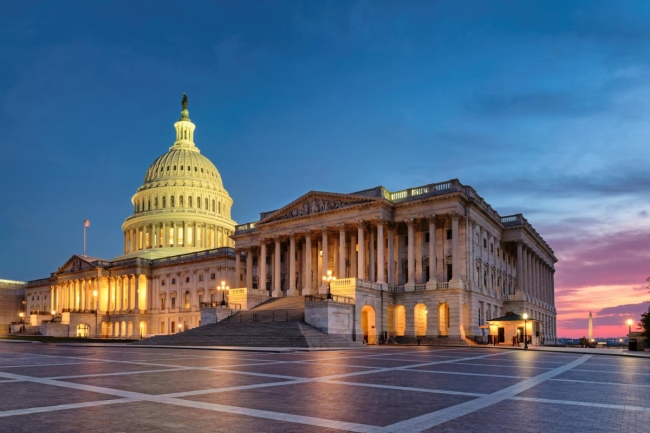You have /5 articles left.
Sign up for a free account or log in.

U.S. Capitol Building
Istockphoto.com/lucky-photographer
As the higher education community receives its first sums of relief funds and anxiously awaits the next stimulus package, it’s important to acknowledge the work of Congress, the U.S. Department of Education and other agencies to pass and implement the CARES Act as quickly as they did. There is deep appreciation for acting quickly. Having said that, it is also essential to examine and correct unforeseen flaws in both the act and the funding.
Unintended consequences happen when policy makers move quickly to help institutions and people. Two examples stem from the certification requirements to receive funds under the Higher Education Emergency Relief Fund (HEERF).
As background, the HEERF provides funds to institutions -- with at least 50 percent of these dollars required to be used to aid students. Last week, the department allocated these student funds. And yesterday the department announced the availability of the funds for institutional uses. However, language in the certification regarding the use of the student funds has created some confusion. That stipulation says,
Recipient shall not use the advanced funds to reimburse itself for any costs or expenses, including but not limited to … any refunds or other benefits that recipient previously issued to students.
Yesterday, the department reiterated that the first allocation of funds is meant to be used as “cash grants” to the student. The department further indicated that institutions may not use the funds to reimburse themselves, except that an institution may reimburse itself if, after the CARES Act enactment on March 27, 2020, it advanced the funds to students for appropriate expenses and so long as it remains clear that 50 percent of all funds are directly provided to the student.
The department deserves credit for listening to concerns raised over the last week, but this new guidance still requires some digestion. To understand the potential impact of this continued limitation, consider the following. By mid-March, many colleges and universities had made the difficult decisions to close. When doing so, some institutions reimbursed or paid students to help alleviate their expenses. At the time, they didn’t know whether or not federal aid would follow. They were just doing the right thing by acting quickly.
Even under the department’s revised guidance, it appears that if these institutions acted too quickly, they may not use the student-directed portion of funds to pay themselves back for the goodwill and fast action demonstrated to their students early on. On the other hand, colleges that waited to close or to pay students may use the student funds to either reimburse themselves or directly pay the students for the same types of expenses.
The department might say that this disparity is OK because the early-acting colleges may use their institutional allocation of funds to reimburse those expenditures, as long as the payments were made on or after March 13, 2020 (the date of President Trump’s Proclamation of National Emergency), and as long as the first funds also are distributed directly to the student. The problem is that many colleges may really need to use the institutional funds to defray their own expenses from having to go online or for other related needs, not for the purposes of student aid.
Again, this is a lot to digest. Why should institutions use institutional funds to defray student expenses, especially since some these institutions really need the 50-50 split mandated by Congress? And why are there two different trigger dates at play for the two funds? It’s hard not to worry about the impact of these nuances on some institutions.
Another unintended consequence comes from how the department’s guidance treats the Federal Work-Study program. On the one hand, the department was very thoughtful in its guidance to encourage closed institutions to continue to pay their FWS students for jobs that no longer exist. Many institutions have done this over the last month, with the nonfederal share of pay coming out of their own budgets. On the other hand, however, the department has now issued guidance that institutions may not use the student-directed funds available to reimburse themselves for their share of the funds already paid to those students. Indeed, the guidance even suggests that an alternative solution may be for institutions to instead consider cutting their share of the students’ pay -- this result would seemingly lower a student’s expected income.
The above examples seem particularly painful for small nonprofit colleges. And that pain doesn’t end here.
That’s because these institutions also are excluded from other relief funds. For example, while some institutions are eligible to receive funds under the Small Business Administration’s Payroll Protection Program, others are not because of an interpretation that includes all student workers as employees in the 500-employee calculation. Adding insult to injury, certain nonprofit organizations also are not eligible to apply to the Federal Reserve’s Main Street Expanded Loan Program.
These hurdles affect institutions across higher education, and therefore the thousands of students who attend them, and it is critically important right now that policy makers emphasize aid to the students. At the same time, when each of these interpretations and restrictions combine, it’s difficult not to see them as potentially impenetrable roadblocks for some of our most cherished and important U.S. colleges. With their endowments and operational revenues in a sudden and steep decline, some of the smaller private, nonprofit institutions appear among the most vulnerable.
So, while the CARES Act represented a strong first effort in March and the department has acted quickly to provide aid to both students and institutions, examination of these nuances demonstrates that the Congress and the executive branch must still work to simultaneously clear the path to stability for both students and institutions.
In short order, the secretary could further clarify the interpretation regarding institutional reimbursements by allowing institutions to use any of the HEERF dollars to replenish their operations accounts so long as they have maintained records to demonstrate that on or after March 13, 2020, they previously used their own funds to appropriately refund or pay students for their losses, and that at least 50 percent of the funds over all were provided to their students.
As additional relief for higher education is considered, attention must focus on how to provide relief to both the institutions and students who need it most. Benefits -- whether through Education Department funding, borrower relief or small business programs -- need to be better targeted to the most deserving students, and at the same time, to the institutions in most need. After all, aid to current students will be fruitless if the institutions they attend are not there to educate them.








